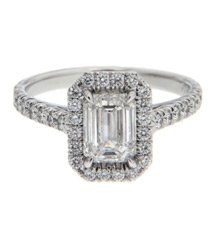La Regente
First documented in 1811, La Regente is a 75 carat naturally formed pearl. This jewel has a symmetrical oval shape, with a distinctive flat side often hidden in the backs of settings. Its luster indicates thick nacre, while its scant blemishing and noted loss of mass over time implies that it had been peeled. At various points in its history, La Regente has sat on headdresses, hung as a necklace drop, and served as the centerpiece of a corsage.
La Regente made its debut on a tiara belonging to Empress Marie-Louise of France. From this showy beginning, the pearl spent several decades as part of the French crown jewels before making its way to Russia and the hands of the royal Yusupov family, where it stayed until 1917. The then pearl vanished from public record until it arrived at a Christie’s sale in 1987. La Regente has since made other appearances at the auction house, once in 1988 and again in 2005, where its illustrious past helped it sell for a record $2.5 million.
The Hope Pearl
Named after its former owner Henry Philip Hope, this jewel is notable for both its size and shape. At 450 carats, its girth alone would make it eye catching, yet the gem boasts a wealth of unusual features. It is at once baroque, a pearl of irregular shape, and a blister pearl, which forms against the shell. The Hope Pearl is flared, with one end wider than the other, with the larger side displaying an array of rounded surfaces.
The Hope Pearl’s coloring is another of its distinctive qualities. While its overall shading is a glossy white, its larger end displays a gradient bronze hue. The pearl’s current mounting emphasizes this color change by affixing a cap of gold, enamel and gemstones at its white tip, ensuring that the bronze hangs down for all to see.
La Peregrina
One of the world’s most notable pearls was in danger of meeting an untimely yet adorable end. La Peregrina was uncovered in the mid-16th century, catching the eyes of royalty. Not only did it weigh over 50 carats, it was and is perfectly symmetrical, a rarity for pearls. While it was initially worn by Mary I of England, the pearl spent centuries among the Spanish royal jewels before making its way to France, England and eventually Elizabeth Taylor.
Soon after Taylor received the jewel, it went missing. After initial panic and careful searching, Taylor noticed one of her puppies chewing, though no one gave it treats. She pried open the mouth of the four legged thief to find La Peregrina wet but unmarred.





